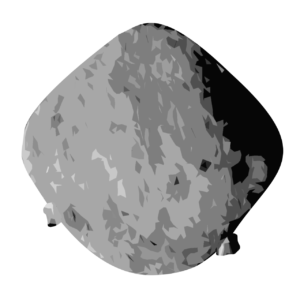The Downlink • Dec 08, 2023
Getting around in space
Space Snapshot

NASA’s Ingenuity helicopter gets where it’s going on Mars, hop by hop. Making short flights, the drone spacecraft has been following the Perseverance rover since they both reached the Martian surface in 2021. Here, Ingenuity looks back at the footprints it left behind as it makes its 66th flight. It will pause for a few weeks while Mars is on the other side of the Sun from the Earth. Image credit: NASA/JPL-Caltech.
Fact Worth Sharing

Japan’s MINERVA-II spacecraft were the first rovers to operate on the surface of an asteroid. The cylindrical rovers, deployed by the Hayabusa-2 mission to Ryugu, got around by making tiny hops and tumbles that carried them relatively far, thanks to the asteroid's low gravity.
Mission Briefings


A perfectly synchronized exoplanet system has been found. Astronomers have identified a star system 100 light-years away with planets whose orbits are in resonance, meaning that each planet’s orbital speed is greater than the last by a simple integer ratio (e.g. 3:2). All star systems, including our own, are thought to have started out in resonance like this one, but it's estimated that only one percent of systems stay that way. Pictured: An artist’s impression of the synchronized star system. Image credit: NASA.

Ireland’s first satellite successfully launched. The Educational Irish Research Satellite, or EIRSAT-1, was designed, built, and tested by students from University College Dublin through ESA Academy’s “Fly Your Satellite!” program, which supported the launch as well as the team’s work on the satellite. EIRSAT-1 will study gamma ray bursts, test a thermal treatment’s ability to protect the surface of a satellite when in space, and test a new method of using Earth’s magnetic field to change a satellite’s orientation in space.

Astronaut Mary Cleave has died. The NASA astronaut flew twice on the Space Shuttle before becoming the first woman to head NASA's science division. Cleave died on Nov. 27 at the age of 76.
From The Planetary Society


The Space Shuttle Program achieved a lot — but did it achieve its main goals? The Shuttle was intended to provide crewed access to orbit at lower costs, with rapid reusability and reliability. John Logsdon, who founded the Space Policy Institute and now serves on The Planetary Society’s board of directors, wrote a paper back in 1986 arguing that the Shuttle program was a policy failure. The latest episode of Planetary Radio: Space Policy Edition revisits this classic paper to discuss its arguments, its conclusions, and whether the paper stands up to this day. Pictured: The Space Shuttle Columbia making its first trip to launchpad. Image credit: NASA.

What caused the largest marsquake ever recorded? Benjamin Fernando, a postdoctoral fellow from the University of Oxford, joins Planetary Radio this week to talk about the 4.7-magnitude marsquake recorded by NASA’s InSight Mars lander in 2022, what we know about it today, and the international effort it took to figure it out.

Marc Hartzman knows a lot about aliens. Specifically, the author and historian knows how to discern between the fact and fiction of UFOs/UAPs and the real possibility of life existing beyond Earth. He joined our latest virtual book club meeting to talk to Planetary Society members about his book “We Are Not Alone.” Watch a recording of the live event and be sure to check out the next meeting in our online member community. Not a member yet? Join us now.
What's Up

Look for Jupiter shining very bright in the east, rising in the early evening and getting higher in the sky as the hours pass. Yellowish Saturn is up in the evening sky as well. On Dec. 9 you’ll see super bright Venus near the crescent Moon in the predawn sky. And get ready for the Geminid meteor shower, one of the best showers of the year, peaking on Dec. 14. Learn more about what else to look for in December’s night skies.
Wow of the Week

The grace and precision of spaceflight was beautifully captured by Stanley Kubrick in the classic film “2001: A Space Odyssey,” but this photo does a good job too. Here you see a SpaceX Dragon cargo spacecraft automatically firing its thrusters to adjust the vehicle's slow, methodical approach toward the International Space Station for docking on Nov. 11, 2023. It was yet another of our choices for November’s best space pictures. Image credit: NASA.
Send us your artwork!
We love to feature space artwork in the Downlink. If you create any kind of space-related art, we invite you to send it to us by replying to any Downlink email or writing to [email protected]. Please let us know in your email if you’re a Planetary Society member!


 Explore Worlds
Explore Worlds Find Life
Find Life Defend Earth
Defend Earth

